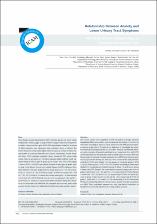Relationship between anxiety and lower urinary tract symptoms

View/
Access
info:eu-repo/semantics/openAccessDate
2016Author
Çevik, RızaBal, Ufuk
Albayrak, Sebahattin
Tanık, Serhat
Zengin, Kürşad
Atar, Muhittin
Gül, Ali İrfan
Metadata
Show full item recordCitation
Çevik, R., Bal, U., Albayrak, S., Tanık, S., Zengin, K., Atar, M., Gül, A. İ. (2016). Relationship between anxiety and lower urinary tract symptoms. Journal of Clinical and Analytical Medicine, 7(4), 430-433.Abstract
Aim: Lower urinary tract symptoms (LUTS) secondary to benign prostatic hyperplasia (BPH) are prevalent and interfere with the quality of life (QoL) of older men. According to observa¬tional, 22.6% of LUTS/BPH patients reported anxiety or depression. The aim of our study was to investigate the potential influences of anxiety and QoL to LUTS/BPH. Material and Method: We examined consecutive 42 patients admitted to our outpatient clinic with LUTS at Bor State Hospital. We examined and recorded maximum urinary flow rate (Qmax) and International Prostate Symptom Score (IPSS) also Hamilton anxiety rating scale for anxiety and IPSS QoL were utilized in the study. Patients according to IPSS were divided into two groups as moderate (group 1, IPSS ?19) and severe (group 2, IPSS >19) LUTS. Patients according to Qmax were divided into two groups as moderate (group 3, Qmax >9) and severe (group 4, Qmax ?9) LUTS. Results: The mean Hamilton anxiety rating scale score of group 1 and 2 were 15.4 ± 3.3 and 21.4 ± 4.5, respectively (P=0.03); of group 3 and 4 were 13.5 ± 2.8 and 17.9 ± 3.5, respectively (P=0.04). The mean QoL score of group 1 and 2 were 3.2 ± 0.6 and 4.2 ± 0.9, respectively (P=0.02); of group 3 and 4 were 3 ± 0.5 and 3.7 ± 0.6, respectively (P=0.02). Discussion: We found relationship between clinical status, anxiety and QoL in patients with BPH. These psychiatric parame¬ters may help identify individuals to benefit from treatment interventions in daily routine practice. © 2016, Journal of Clinical and Analytical Medicine. All rights Reserved. Giriş: Benign prostat hiperplazisi’ne (BPH) sekonder gelişen alt üriner sistem semptomları (AÜSS) yaygın ve yaşlı erkeklerin yaşam kalitesini etkileyen bir durumdur. Araştırmacılara göre AÜSS/BPH hastalarının önemli bir oranında (% 22,6) anksiyete veya depresyon rapor edilmiştir. Gereç ve Yöntem: Bor Devlet Hastanesi üroloji polikliniğine AÜSS ile başvuran ardışık 42 hasta muayene edildi ve maximum idrar akım hızı (Qmax), Uluslararası Prostat Semptom Skoru (IPSS) sonuçları kaydedildi. Ayrıca hastalarda IPSS yaşam kalite endexi (QoL) ve anksiyete için Hamilton anksiyete değerlendirme ölçeği kullanıldı. Hastalar IPSS’ye göre iki gruba ayrıldı. Grup 1 orta (IPSS ≤19) ve grup 2 şiddetli (IPSS >19) AÜSS. Aynı şeklide hastalar Qmax’a göre iki gruba ayrıldı. Grup 3 orta (Qmax >9) ve grup 4 şiddetli (Qmax ≤9) AÜSS. Bulgular: Ortalama Hamilton anksiyete değerlendirme ölçeği puanı grup 1 ve 2’de sırasıyla 15.4 ± 3.3 ve 21.4 ± 4.5 (P=0.03) idi. Grup 3 ve 4’te ise sırasıyla 13.5 ± 2.8 ve 17.9 ± 3.5 (P=0.04) idi. Ortalama QoL endexi puanı grup 1 ve 2’de sırasıyla 3.2 ± 0.6 ve 4.2 ± 0.9 (P=0.02) idi. Grup 3 ve 4’te ise sırasıyla 3 ± 0.5 and 3.7 ± 0.6 (P=0.02) idi. Tartışma: Çalışmamızda BPH hastalarının kliniği ile anksiyete ve Qol arasındaki ilişki belirlendi. Bu psikiyatrik parametreler günlük rutin pratikte bireyler tedavi ve müdahalelerinin belirlenmesinde yardımcı olabilir.

















